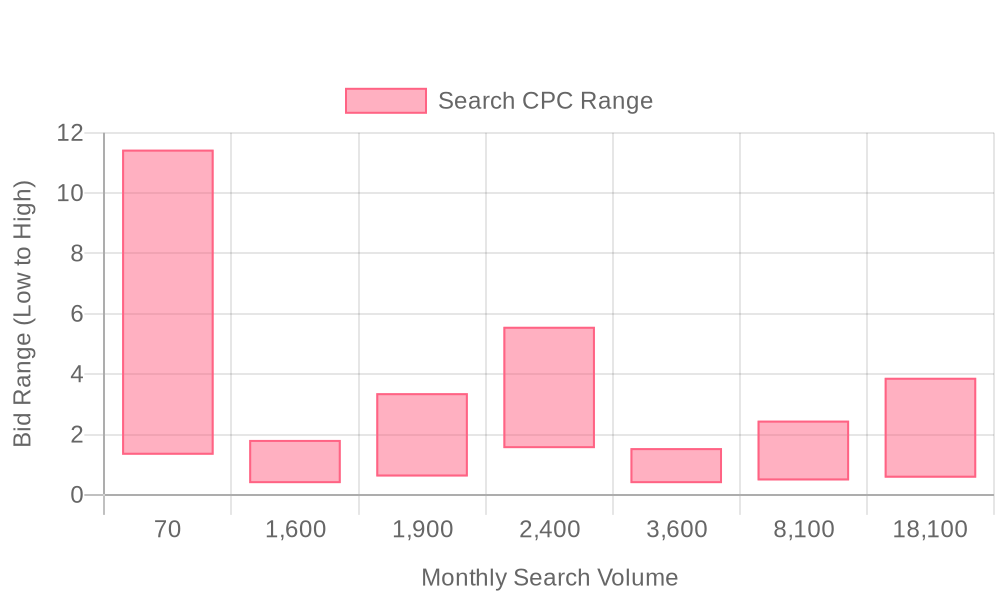
Supercharge your lead generation with a FREE Google Ads audit - no strings attached! See how you can generate more and higher quality leads
Get My Free Google Ads AuditFree consultation

No commitment
Supercharge your lead generation with a FREE LinkedIn Ads audit - no strings attached! See how you can generate more and higher quality leads
Get My Free Google Ads AuditFree consultation

No commitment
Supercharge your lead generation with a FREE Meta Ads audit - no strings attached! See how you can generate more and higher quality leads
Get My Free Google Ads AuditGet My Free LinkedIn Ads AuditGet My Free Meta Ads AuditFree consultation

No commitment
Supercharge your lead generation with a FREE Google Ads audit - no strings attached! See how you can generate more and higher quality leads
Get My Free Google Ads AuditFree consultation

No commitment
In today's competitive digital marketing landscape, capturing the attention of potential customers is paramount, especially for niche products like car diffusers. These products face unique challenges, such as high demo interest that goes unconverted due to a lack of follow-up mechanisms. Google Ads for Car Diffusers presents a unique opportunity for businesses to tap into high-intent searches and reach potential buyers at the exact moment they're ready to make a purchasing decision. Advanced tools now allow businesses to flag visitors before they convert, enabling timely and relevant engagement through Google Ads. By leveraging data-driven insights and strategic ad placements, you can effectively create targeted campaigns that drive conversions and enhance brand visibility.

Effective lead generation for car diffusers requires a blend of precise targeting, compelling creative, and integrated measurement. Teams that successfully execute Google Ads for Car Diffusers campaigns leverage data-driven decisions at every stage, from keyword discovery to conversion tracking, ensuring that each dollar spent brings measurable returns. By harnessing real-time audience insights and aligning messaging with buyer intent, marketers can move prospects efficiently through the funnel while adapting to evolving consumer behavior.
This step-by-step framework outlines how to build a modern Google Ads program for car diffuser and automotive product marketing, highlighting advanced tactics that unify audience data, personalize engagement, and maximize ROI.
Identifying high-conversion search terms is the foundation of a successful car diffuser advertising strategy. Focus on both broad and niche keywords, such as “car air freshener diffuser,” “essential oil car diffuser,” and “best diffuser for cars,” to capture intent across the awareness and consideration stages. Use search trend analysis and first-party data to prioritize terms with clear commercial intent, filtering out generic queries that rarely convert. When advanced platforms are integrated, marketers can enrich keyword research with real-time intent data, revealing hidden opportunities and surfacing leads that are most likely to convert. For a comprehensive overview of current best practices, review this Google Ads optimization guide. This approach enables a shift in ad spend toward the highest-priority accounts, while suppressing budget for low-propensity segments.

Organizing campaigns into targeted ad groups elevates relevance and Quality Score. Map ad groups to specific product features (for example, “long-lasting car diffusers,” “luxury automotive scents,” or “vent clip diffusers”) or to distinct audience interests (“eco-friendly car accessories,” “tech-savvy drivers”). Sophisticated segmentation tools allow marketers to automatically update ad groups as leads progress through the buyer journey, ensuring that messaging and creative resonate at every touchpoint. For additional strategies, explore actionable playbooks for campaign segmentation. Dynamic audience management ensures that as prospects demonstrate new behaviors or engage with additional content, they are seamlessly moved into the most relevant ad groups, maintaining high engagement rates and minimizing wasted impressions.

Persuasive ad copy is essential for driving clicks and conversions in online advertising for car products. Highlight unique selling points, such as “30-day fragrance,” “no spill design,” or “natural essential oils,” and address key pain points like lingering odors or chemical sensitivities. Integrate urgency or exclusivity messages—such as “limited edition scents” or “free shipping this week”—to boost response rates. Personalization is elevated when marketers leverage visitor behavior data and account history; this allows for tailored messaging that speaks directly to the prospect’s needs, increasing the likelihood of engagement. For inspiration, see this step-by-step guide to Google Ads for auto detailing. With automated triggers and timely follow-up, engagement rates climb, and the overall cost per lead decreases.
A seamless user experience from ad click to conversion is vital in PPC for car diffusers and broader automotive e-commerce. Landing pages must align with ad messaging, feature clear calls to action, and minimize friction points in the path to purchase. Test different layouts, headlines, and form lengths to identify the optimal combination for driving conversions. For teams using unified data platforms, landing page experiences can be dynamically personalized based on visitor segment, device, or campaign source, leading to higher conversion rates and lower bounce rates. Continuous optimization, informed by integrated attribution, ensures that messaging and offers remain consistent across every touchpoint, reducing drop-off and increasing lead quality.
Car diffusers occupy a unique intersection in automotive product marketing, where consumer awareness and purchase intent can shift rapidly with trends and seasonal demands. Google Ads enables brands to capture these moments with precision, engaging shoppers at the exact point of need, and amplifying the impact of every ad dollar by connecting with buyers actively searching for automotive scent solutions. For a comprehensive overview of optimization techniques, see Google Ads best practices.


Growth in the car diffuser market stems from identifying pockets of untapped demand and outmaneuvering less agile competitors. B2B revenue teams can drive measurable ROI by targeting high-intent buyers, optimizing campaign spend, and ensuring that every digital touchpoint supports customer conversion.
Precise audience segmentation is the backbone of high-impact Google Ads for car diffusers and related automotive accessories. When you define and refine your segments, every impression and click aligns more closely with your buyers’ motivations, maximizing relevance and ad spend efficiency. This approach enables teams to deploy creative, data-driven strategies that connect directly with real purchase intent and lifecycle stage. For a comprehensive overview of current optimization tactics, review these Google Ads best practices.
Effective audience segmentation is the catalyst for better targeting, higher engagement, and stronger returns in digital marketing for car accessories. When segmentation, intent data, and creative are unified within your advertising workflow, you build a growth engine that adapts in real time and consistently delivers results across every stage of the automotive e-commerce funnel. Ready to take the next step? Get started for free with Sona.

| Industry | Keyword | Monthly Search Volume | Competition Level | Low Bid | High Bid |
| Car Diffusers | mini 360 diffuser | 70 | HIGH | 1.33 | 11.44 |
| Car Diffusers | jo malone car diffuser | 1600 | HIGH | 0.39 | 1.82 |
| Car Diffusers | acqua di parma car diffuser | 1900 | HIGH | 0.61 | 3.37 |
| Car Diffusers | car scent diffuser | 2400 | HIGH | 1.55 | 5.57 |
| Car Diffusers | diptyque car diffuser | 3600 | HIGH | 0.39 | 1.55 |
| Car Diffusers | pura car diffuser | 8100 | HIGH | 0.48 | 2.46 |
| Car Diffusers | car diffusers | 18100 | HIGH | 0.57 | 3.88 |
A robust keyword strategy is the cornerstone of any high-performing campaign in the car diffuser vertical. B2B marketers and automotive e-commerce teams must address every stage of intent while accounting for location, specificity, and negative matches to prevent wasted spend and maximize conversion rates for Google Ads for Car Diffusers.
A fully realized keyword strategy for car diffuser advertising covers both broad and narrow intent, leverages geographic targeting, and continually refines its scope via negative keywords and CRM insights. This approach empowers B2B revenue teams to capture high-quality demand, reduce wasted ad spend, and drive measurable growth for automotive e-commerce and retail brands. To see how this can work for your team, get started for free with Sona.
Effective keyword selection forms the core of every successful Google Ads for Car Diffusers campaign. Start by clustering keywords based on product features, such as “essential oil car diffuser,” “long-lasting car scent,” or “wireless car air freshener.” Align these clusters with consumer interests, including eco-friendly drivers or tech-savvy car owners, to ensure precise relevance. Incorporating regional modifiers like city names or local slang enables hyper-local reach, letting marketers capture demand in areas with heightened interest or specific regulatory requirements for automotive accessories.
Audience quality improves when negative keywords filter out unrelated searches, such as those looking for DIY air freshener recipes or unrelated vehicle services. As the campaign matures, use performance data to dynamically adjust keyword lists. Platforms that unify web visitor data with CRM insights streamline this process, helping marketers spot high-potential audience segments and adjust bids or ad targeting in real time. For a comprehensive overview of optimization strategies, review the Google Ads best practices resource. This ensures that every dollar spent is focused on audiences most likely to convert, maximizing both campaign efficiency and ROI.
The ad copy for car diffuser advertising must stand out in a crowded automotive product marketing landscape. Highlight unique selling propositions like “30-day fragrance guarantee,” “phthalate-free oils,” or “smartphone-controlled diffusion” to appeal to quality-conscious buyers. Emotional benefits, such as improved driving relaxation or a personalized cabin environment, resonate especially well with premium segments. Dynamic keyword insertion tailors each ad to a user’s search query, increasing click-through and keeping brand messaging relevant to each stage of the buyer journey.
Personalization extends beyond keyword adaptation. As leads move through the funnel, update creative assets and calls to action to reflect their engagement level—first-time visitors might see “Try Now” offers, while previous purchasers receive upgrade or refill suggestions. Integrating real-time behavioral signals from site and CRM data lets marketers trigger hyper-relevant messages, making each ad a tailored experience that drives measurable engagement and conversion. Explore additional campaign insights and strategies to fine-tune messaging throughout the buyer journey.
A seamless experience from ad to landing page is essential in digital marketing for car accessories. Ensure that every landing page continues the narrative started in the ad—mirroring messaging, colors, and featured products removes friction and builds trust. Including customer testimonials, ratings, and reviews can elevate purchase confidence, especially for first-time buyers of automotive e-commerce products. Clear purchase options and well-placed calls to action facilitate a smooth path to conversion, reducing bounce rates and abandoned carts.
Consistency is key for both online-only and omnichannel brands. Syncing data between Google Merchant Center for car products and the landing page inventory ensures that product availability and pricing are always accurate. For guidance on maximizing your Google Shopping Ads, review the latest 2024 performance guide. Advanced platforms help marketers identify returning visitors and personalize landing content based on previous interactions, increasing relevance and driving higher average order values.
Continuous optimization distinguishes top-performing PPC for car diffusers campaigns. Regular A/B testing of ad headlines, images, and calls to action reveals creative elements that best drive engagement. Test different bid strategies and adjust audience targeting as new data emerges—shifting budget toward segments that show higher conversion rates for car diffuser ads. Fast, informed decision-making ensures campaigns remain agile in response to market trends or seasonality.
Performance analytics should guide every adjustment. Integrating conversion tracking from online and offline channels provides a full view of ROI, allowing marketers to attribute sales to the right touchpoints—whether a click drove an online sale or a store visit. Real-time intent signals can inform bid increases for high-intent visitors, while CRM and ad platform syncs keep dynamic audiences up to date as leads progress through the funnel. Discover how AI-powered audiences impact Google Ads performance for automotive brands. To experience integrated campaign performance and optimization firsthand, get started for free with Sona.
Expanding your car diffuser business requires more than basic advertising. A unified approach to digital strategy delivers deeper insights into customer behavior and drives higher engagement across all channels. For a deeper dive into advanced marketing analytics and tactics, explore our curated blog resources.
Positioning car diffusers effectively in the competitive automotive accessory landscape relies on data-driven insights, granular targeting, and creative ad execution. Challenges such as high demo interest that does not convert, or leads that cool off without timely follow-up, can be addressed with advanced predictive tools and integrated attribution models that reveal where prospects drop off and how to reactivate them. By building targeted keyword lists, structuring campaigns for maximum flexibility, and adapting based on unified performance metrics, you can optimize Google Ads for Car Diffusers and scale your brand’s reach in the digital marketplace. If you're ready to take your strategy to the next level, get started for free with Sona.
Navigating the world of Google Ads for car diffusers can be a transformative journey, guiding you toward more effective online advertising strategies. By aligning your campaigns with specific audience targeting, optimizing ad creatives, and leveraging data-driven insights, you can significantly enhance your product's visibility and engagement.
Throughout this article, we explored the essential strategies to elevate your car diffuser brand using Google Ads. We delved into understanding the importance of keyword research, crafting compelling ad copy, and utilizing performance metrics to refine your approach. These elements are crucial in overcoming the challenges that come with digital advertising and ensuring your campaigns are cost-effective and impactful.
Imagine the potential growth when you apply these best practices to your advertising efforts. With the right tools and strategies, the possibilities for expanding your brand's reach are vast. Embrace this opportunity to transform your marketing approach and connect with your target audience more effectively.
To truly harness the power of these insights and tools, start for free and explore how our platform can elevate your advertising strategy. This is your chance to experience the difference that a data-driven approach can make in your business's success.
Best practices include leveraging data-driven insights, precise targeting with niche and broad keywords, creating compelling ad groups, and using personalized ad copy to enhance engagement and conversions.
Budget allocation should focus on high-priority accounts and high-intent keywords, dynamically adjusting based on conversion data to ensure each dollar supports the most valuable opportunities.
Use a mix of high-intent keywords like 'buy car diffusers' and niche terms such as 'best essential oil car diffusers for SUVs,' while incorporating location-specific modifiers and managing negative keywords to filter out irrelevant traffic.
Create effective ads by highlighting unique selling points, using dynamic keyword insertion, and personalizing messages based on visitor behavior and engagement level to improve click-through and conversion rates.
Common mistakes include failing to use negative keywords to filter out irrelevant traffic, not personalizing ad messaging for specific audience segments, and overlooking the importance of landing page alignment with ad content.
Join results-focused teams combining Sona Platform automation with advanced Google Ads strategies to scale lead generation

Connect your existing CRM

Free Account Enrichment

No setup fees
No commitment required

Free consultation

Get a custom Google Ads roadmap for your business
Join results-focused teams combining Sona Platform automation with advanced Meta Ads strategies to scale lead generation

Connect your existing CRM

Free Account Enrichment

No setup fees
No commitment required

Free consultation

Get a custom Google Ads roadmap for your business
Join results-focused teams combining Sona Platform automation with advanced LinkedIn Ads strategies to scale lead generation

Connect your existing CRM

Free Account Enrichment

No setup fees
No commitment required

Free consultation

Get a custom Google Ads roadmap for your business
Join results-focused teams using Sona Platform automation to activate unified sales and marketing data, maximize ROI on marketing investments, and drive measurable growth

Connect your existing CRM

Free Account Enrichment

No setup fees
No commitment required

Free consultation

Get a custom Google Ads roadmap for your business
Over 500+ auto detailing businesses trust our platform to grow their revenue
Join results-focused teams using Sona Platform automation to activate unified sales and marketing data, maximize ROI on marketing investments, and drive measurable growth

Connect your existing CRM

Free Account Enrichment

No setup fees
No commitment required

Free consultation

Get a custom Google Ads roadmap for your business
Over 500+ auto detailing businesses trust our platform to grow their revenue
Join results-focused teams using Sona Platform automation to activate unified sales and marketing data, maximize ROI on marketing investments, and drive measurable growth

Connect your existing CRM

Free Account Enrichment

No setup fees
No commitment required

Free consultation

Get a custom Google Ads roadmap for your business
Over 500+ auto detailing businesses trust our platform to grow their revenue
Our team of experts can implement your Google Ads campaigns, then show you how Sona helps you manage exceptional campaign performance and sales.
Schedule your FREE 15-minute strategy sessionOur team of experts can implement your Meta Ads campaigns, then show you how Sona helps you manage exceptional campaign performance and sales.
Schedule your FREE 15-minute strategy sessionOur team of experts can implement your LinkedIn Ads campaigns, then show you how Sona helps you manage exceptional campaign performance and sales.
Schedule your FREE 15-minute strategy sessionOur team of experts can help improve your demand generation strategy, and can show you how advanced attribution and data activation can help you realize more opportunities and improve sales performance.
Schedule your FREE 30-minute strategy sessionOur team of experts can help improve your demand generation strategy, and can show you how advanced attribution and data activation can help you realize more opportunities and improve sales performance.
Schedule your FREE 30-minute strategy sessionOur team of experts can help improve your demand generation strategy, and can show you how advanced attribution and data activation can help you realize more opportunities and improve sales performance.
Schedule your FREE 30-minute strategy sessionOur team of experts can help improve your demand generation strategy, and can show you how advanced attribution and data activation can help you realize more opportunities and improve sales performance.
Schedule your FREE 30-minute strategy session





Launch campaigns that generate qualified leads in 30 days or less.
